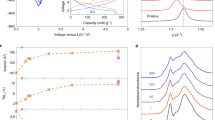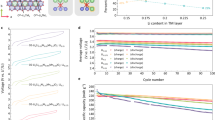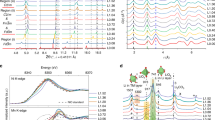Abstract
Although Li-rich layered oxides (Li1+xNiyCozMn1−x−y−zO2 > 250 mAh g−1) are attractive electrode materials providing energy densities more than 15% higher than today’s commercial Li-ion cells, they suffer from voltage decay on cycling. To elucidate the origin of this phenomenon, we employ chemical substitution in structurally related Li2RuO3 compounds. Li-rich layered Li2Ru1−yTiyO3 phases with capacities of ~240 mAh g−1 exhibit the characteristic voltage decay on cycling. A combination of transmission electron microscopy and X-ray photoelectron spectroscopy studies reveals that the migration of cations between metal layers and Li layers is an intrinsic feature of the charge–discharge process that increases the trapping of metal ions in interstitial tetrahedral sites. A correlation between these trapped ions and the voltage decay is established by expanding the study to both Li2Ru1−ySnyO3 and Li2RuO3; the slowest decay occurs for the cations with the largest ionic radii. This effect is robust, and the finding provides insights into new chemistry to be explored for developing high-capacity layered electrodes that evade voltage decay.
This is a preview of subscription content, access via your institution
Access options
Subscribe to this journal
Receive 12 print issues and online access
$259.00 per year
only $21.58 per issue
Buy this article
- Purchase on Springer Link
- Instant access to full article PDF
Prices may be subject to local taxes which are calculated during checkout






Similar content being viewed by others
References
Whittingham, M. S. Materials challenges facing electrical energy storage. MRS Bull. 33, 411–419 (2008).
Armand, M. & Tarascon, J-M. Building better batteries. Nature 451, 652–657 (2008).
Palacin, M. R. Recent advances in rechargeable battery materials: A chemist’s perspective. Chem. Soc. Rev. 38, 2565–2575 (2009).
Armand, M. & Tarascon, J-M. Issues and challenges facing rechargeable lithium batteries. Nature 414, 359–367 (2001).
Prosini, P. P. Iron Phosphate Materials as Cathodes for Lithium Batteries (Springer, 2011).
Rousse, G. & Tarascon, J-M. Sulfate-based polyanionic compounds for Li-ion batteries: Synthesis, crystal chemistry, and electrochemistry aspects. Chem. Mater. 26, 294–406 (2014).
He, P., Yu, H., Li, D. & Zhou, H. Layered lithium transition metal oxide cathodes towards high energy lithium-ion batteries. J. Mater. Chem. 22, 3680–3695 (2012).
Ohzuku, T. & Makimura, Y. Layered lithium insertion material of LiCo1/3Ni1/3Mn1/3O2 for lithium-ion batteries. Chem. Lett. 30, 642–643 (2001).
Koyama, Y., Tanaka, I., Adachi, H., Makimura, Y. & Ohzuku, T. Crystal and electronic structures of superstructural Li1−x[Co1/3Ni1/3Mn1/3]O2 (0 ≤ x ≤ 1). J. Power Sources 119–121, 644–648 (2003).
Thackeray, M. M. et al. Li2MnO3-stabilized LiMO2 (M = Mn, Ni, Co) electrodes for lithium-ion batteries. J. Mater. Chem. 17, 3112–3125 (2007).
Zhou, F., Zhao, X., van Bommel, A., Xia, X. & Dahn, J. R. Comparison of Li[Li1/9Ni1/3Mn5/9]O2, Li[Li1/5Ni1/5Mn3/5]O2, LiNi0.5Mn1.5O4, and LiNi2/3Mn1/3O2 as high voltage positive electrode materials. J. Electrochem. Soc. 158, A187–A191 (2011).
Sathiya, M. et al. Reversible anionic redox chemistry in high-capacity layered-oxide electrodes. Nature Mater. 12, 827–835 (2013).
Koga, H. et al. Reversible oxygen participation to the redox processes revealed for Li1.20Mn0.54Co0.13Ni0.13O2 . J. Electrochem. Soc. 160, A786–A792 (2013).
Bettge, M. et al. Voltage fade of layered oxides: Its measurement and impact on energy density. J. Electrochem. Soc. 160, A2046–A2055 (2013).
Gallagher, K. G. et al. Correlating hysteresis and voltage fade in lithium- and manganese-rich layered transition-metal oxide electrodes. Electrochem. Commun. 33, 96–98 (2013).
Croy, J. R. et al. Examining hysteresis in composite xLi2MnO3 ⋅ (1 − x)LiMO2 cathode structures. J. Phys. Chem. C 117, 6525–6536 (2013).
Gu, M. et al. Formation of the spinel phase in the layered composite cathode used in Li-ion batteries. ACS Nano 7, 760–767 (2012).
Mohanty, D. et al. Investigating phase transformation in the Li1.2Co0.1Mn0.55Ni0.15O2 lithium-ion battery cathode during high-voltage hold (4.5 V) via magnetic, X-ray diffraction and electron microscopy studies. J. Mater. Chem. A 1, 6249–6261 (2013).
Ito, A. et al. Direct observation of the partial formation of a framework structure for Li-rich layered cathode material Li[Ni0.17Li0.2Co0.07Mn0.56]O2 upon the first charge and discharge. J. Power Sources 196, 4785–4790 (2011).
Zheng, J. et al. Corrosion/fragmentation of layered composite cathode and related capacity/voltage fading during cycling process. Nano Lett. 13, 3824–3830 (2013).
Croy, J. R. et al. Countering the voltage decay in high capacity xLi2MnO3 ⋅ (1 − x)LiMO2 electrodes (M = Mn, Ni, Co) for Li+-ion batteries. J. Electrochem. Soc. 159, A781–A790 (2012).
Hong, J. et al. Structural evolution of layered Li1.2Ni0.2Mn0.6O2 upon electrochemical cycling in a rechargeable battery. J. Mater. Chem. 20, 10179–10186 (2010).
Xu, B., Fell, C-R., Chi, M. & Meng, Y-S. Identifying surface structural changes in layered Li-excess nickel manganese oxides in high voltage lithium ion batteries: A joint experimental and theoretical study. Energy Environ. Sci. 4, 2223–2233 (2011).
Sathiya, M. et al. High performance Li2Ru1−yMnyO3 (0.2 ≤ y ≤ 0.8) cathode materials for rechargeable lithium-ion batteries: Their understanding. Chem. Mater. 25, 1121–1131 (2013).
Reed, J. & Ceder, G. Role of electronic structure in the susceptibility of metastable transition-metal oxide structures to transformation. Chem. Rev. 104, 4513–4534 (2004).
Kang, K. & Ceder, G. Factors that affect Li mobility in layered lithium transition metal oxides. Phys. Rev. B 74, 094105 (2006).
Yu, H. & Zhou, H. High-energy cathode materials (Li2MnO3–LiMO2) for lithium-ion batteries. J. Phys. Chem. Lett. 4, 1268–1280 (2013).
Kang, S. H. et al. Interpreting the structural and electrochemical complexity of 0.5Li2MnO3.0.5LiMO2 electrodes for lithium batteries (M = Mn0.5−xNi0.5−xCo2x, 0 ≤ x ≤ 0.5). J. Mater. Chem. 17, 2069–2077 (2007).
Manju, U., Awana, V. P. S., Kishan, H. & Sarma, D. D. X-ray photoelectron spectroscopy of superconducting RuSr2Eu1.5Ce0.5Cu2O10 and nonsuperconducting RuSr2EuCeCu2O10 . Phys. Rev. B 74, 245106 (2006).
Dupin, J-C., Gonbeau, D., Vinatier, P. & Levasseur, A. Systematic XPS studies of metal oxides, hydroxides and peroxides. Phys. Chem. Chem. Phys. 2, 1319–1324 (2000).
Atuchin, V. V., Kesler, V. G., Pervukhina, N. V. & Zhang, Z. Ti 2p and O 1s core levels and chemical bonding in titanium-bearing oxides. J. Electron Spectrosc. Relat. Phenom. 152, 18–24 (2006).
Arillo, M. A. et al. Surface characterisation of spinels with Ti(IV) distributed in tetrahedral and octahedral sites. J. Alloys Compd. 317–318, 160–163 (2001).
Kang, K. et al. Synthesis and electrochemical properties of layered Li0.9Ni0.45Ti0.55O2 . Chem. Mater. 15, 4503–4507 (2003).
Morra, E., Giamello, E. & Chiesa, M. Probing the redox chemistry of titanium silicate-1: Formation of tetrahedral Ti3+ centers by reaction with triethyl aluminium. Chemistry 20, 7381–7388 (2014).
Lopez, M. C. et al. Tunable Ti4+/Ti3+ redox potential in the presence of iron and calcium in NASICON-type related phosphates as electrodes for lithium batteries. Chem. Mater. 25, 4025–4035 (2013).
Lu, Z. & Dahn, J. R. In situ and ex situ XRD investigation of Li[CrxLi1/3−x/3Mn2/3−2x/3]O2 (x = 1/3) cathode material. J. Electrochem. Soc. 150, A1044–A1051 (2003).
Bak, S-M. et al. Correlating structural changes and gas evolution during the thermal decomposition of charged LixNi0.8Co0.15Al0.05O2 cathode materials. Chem. Mater. 25, 337–351 (2013).
Morcrette, M. et al. A reversible copper extrusion-insertion electrode for rechargeable Li batteries. Nature Mater. 2, 755–761 (2003).
Qian, J., Qiao, D., Ai, X., Cao, Y. & Yang, H. Reversible 3-Li storage reactions of amorphous phosphorus as high capacity and cycling-stable anodes for Li-ion batteries. Chem. Commun. 48, 8931–8933 (2012).
Poizot, P. et al. Evidence of an electrochemically assisted ion exchange reaction in Cu2.33V4O11 electrode material vs. Li. Electrochem. Solid-State Lett. 8, A184–A187 (2005).
Lee, J. et al. Unlocking the potential of cation-disordered oxides for rechargeable lithium batteries. Science 343, 519–522 (2014).
Reed, J., Ceder, G. & Van Der Ven, A. Layered-to-spinel phase transition in LixMnO2 . Electrochem. Solid-State Lett. 4, A78–A81 (2001).
Yabuuchi, N. et al. 224th ECS Meeting (The Electrochemical Society, 2013).
Rietveld, H. M. A profile refinement method for nuclear and magnetic structures. J. Appl. Crystallogr. 2, 65–71 (1969).
Rodriguez-Carvajal, J. Recent advances in magnetic-structure determination by neutron powder diffraction. Physica B 192, 55–69 (1993).
Kresse, G. & Furthmüller, J. Efficiency of ab-initio total energy calculations for metals and semiconductors using a plane-wave basis set. Comput. Mater. Sci. 6, 15–50 (1996).
Kresse, G. & Hafner, J. Ab initio molecular dynamics for liquid metals. Phys. Rev. B 47, 558–561 (1993).
Perdew, J. P., Burke, K. & Ernzerhof, M. Generalized gradient approximation made simple. Phys. Rev. Lett. 77, 3865–3868 (1996).
Acknowledgements
The authors acknowledge both ALISTORE-ERI and RS2E institutions for fully supporting this work. G.V.T. acknowledges the European Research Council, ERC grant No. 246791–COUNTATOMS. The research leading to these results has received funding from the European Union Seventh Framework Programme under Grant Agreement 312483-ESTEEM2 (Integrated Infrastructure Initiative–I3). C.P.L. thanks the CSIR, New Delhi for granting a Senior Research Fellowship. Use of the APS (Advanced Photon Source) at Argonne National Laboratory (ANL) supported by the US Department of Energy under Contract No. DE-AC02-06CH11357 is greatly acknowledged. J. Kurzman is acknowledged for support in editing the manuscript.
Author information
Authors and Affiliations
Contributions
M.Sathiya, K.R., C.P.L. and A.S.P. carried out the synthesis, M.Sathiya, and J-M.T. conducted the electrochemical work and J-M.T. designed the research approach; G.R. analysed the crystal structures and diffraction patterns; A.M.A. and G.V.T. carried out, analysed and exploited the electron diffraction and HAADF-STEM studies; D.F. and D.G. collected and analysed the XPS spectra; M.Saubanère and M.L.D. conducted the DFT calculations and developed the theoretical framework; M.Sathiya, A.M.A. and J-M.T. wrote the manuscript and all authors discussed the experiments and final manuscript.
Corresponding author
Ethics declarations
Competing interests
The authors declare no competing financial interests.
Supplementary information
Supplementary Information
Supplementary Information (PDF 5013 kb)
Rights and permissions
About this article
Cite this article
Sathiya, M., Abakumov, A., Foix, D. et al. Origin of voltage decay in high-capacity layered oxide electrodes. Nature Mater 14, 230–238 (2015). https://doi.org/10.1038/nmat4137
Received:
Accepted:
Published:
Issue Date:
DOI: https://doi.org/10.1038/nmat4137
This article is cited by
-
Structurally robust lithium-rich layered oxides for high-energy and long-lasting cathodes
Nature Communications (2024)
-
Slab gliding, a hidden factor that induces irreversibility and redox asymmetry of lithium-rich layered oxide cathodes
Nature Communications (2023)
-
Impacts of Mg doping on the structural properties and degradation mechanisms of a Li and Mn rich layered oxide cathode for lithium-ion batteries
Scientific Reports (2023)
-
In situ formed partially disordered phases as earth-abundant Mn-rich cathode materials
Nature Energy (2023)
-
Understanding voltage hysteresis and decay during anionic redox reaction in layered transition metal oxide cathodes: A critical review
Nano Research (2023)



